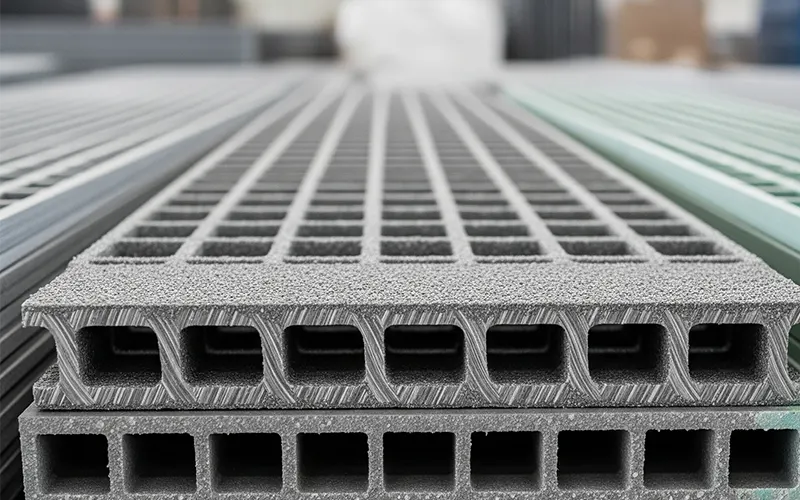
Conventionally, flooring grates have been used in several industrial situations, where they are significant for drainage, aeration, and ensuring individuals can walk securely in tough places. With the introduction of fibreglass reinforced plastic (FRP), a new era of innovation has begun.
This has changed how people think about and use flooring grates. This advanced material can be modified in ways that go beyond what most companies need, which opens up a world of possibilities for other sectors and architectural styles.
This blog will look at how FRP flooring grates may be used in a wide range of situations because they are so flexible. It will show how custom solutions can suit both important functional needs and specific aesthetic needs.
FRP's development began in the early 1900s when researchers were looking for materials that would combine strength and corrosion resistance. The amazing properties of FRP grating are currently revolutionizing sectors. Flooring Grates offer drainage, ventilation, and safe footing when considered in their Industrial context. This marked an age of innovation, and it changed the way flooring grates were used. Fiberglass Reinforced Plastic Grating, or FRP, is lightweight, quite durable, and long-lasting.
The Old Role of Flooring Grates
For many years, flooring grates have been quite important in many industrial settings. Their main jobs are to provide good drainage for spills and washdown, allow for good ventilation in small spaces, provide stable and safe walking surfaces for people and equipment, and meet strict load-bearing requirements in heavy-duty working areas. Steel is the most common material used to make traditional flooring grates. They are strong, but they can rust easily, especially in wet or chemically harsh places.
What Are FRP Gratings?
Continuous glass fibers are used to reinforce thermosetting resin to create grid-like panels known as FRP gratings. With respect to the requirements of the application, these gratings are either pultruded or molded. They are perfect for industries wherein metal alternatives fail because of rust, electric conductivity, or weight restrictions, because of their lightweight structure, great strength, resistance to corrosion, and non-conductive qualities.
FRP Grating's composition and production
Fiberglass strands and a resin matrix are used to create FRP grating. Either molding or pultrusion is used in the usual manufacturing process, and each gives the finished product unique properties. The selection of materials and production process greatly influences the quality and use of FRP grating.
FRP Grating's Features and Properties
Because of its exceptional strength-to-weight ratio, FRP grating is lightweight to handle yet performs like a heavyweight. Unlike conventional materials, it is resistant to corrosion and a variety of substances. Its simplicity of installation also saves time and labor expenses.
Role of FRP in Industrial Flooring
The capabilities of flooring grates have been transformed by the emergence of fiberglass reinforced plastic (FRP), a contemporary, cutting-edge material. With several benefits, FRP molded grating presents a strong substitute for conventional materials. A high strength-to-weight ratio and optimum corrosion resistance offer a guarantee of longevity in tough situations as well.
Commercial Spaces
FRP pultruded grating manufacturers produce hard-wearing and corrosion-resistant grating solutions that are applicable to various sectors. In addition to providing necessary drainage for pool splash and rain, this lightweight solution's resistance to corrosion guarantees longevity in the chemically treated environment.
Waterfront and Marine Environments
FRP was selected for a boat launch dock in Alaska's remote Kenai River channel. FRP offers corrosion resistance that can occur because of constant exposure to seawater. In addition to providing crucial slip resistance for pedestrian safety and corrosion resistance against the river environment, the specially designed mesh grating allowed sunlight to penetrate, protecting aquatic flora.
Food and Beverage Industry
In the food and beverage industry, cleanliness and the convenience of cleaning are essential. In a plant that is regularly cleaned, the Great Plains Coca-Cola Bottling Company in Oklahoma City realized the advantages of FRP flooring grates because of their resistance to corrosion and slippage. Along packaging units and conveyor lines, the molded FRP grating gave workers a secure and stable surface. Furthermore, FRP's inherent durability provided ergonomic advantages that lessened worker fatigue. The option to select a hue that closely matched the Coca-Cola logo demonstrated FRP's aesthetic versatility even more.
Conclusion
Reputable FRP pultruded grating manufacturers offer cutting-edge, personalized FRP flooring grate solutions. The vast knowledge and engineering skills enable to design of customized gratings that satisfy certain functional and aesthetic needs for a variety of applications. Numerous customization choices are available for FRP gratings, such as mesh patterns, size, shape, color, surface roughness, and load capacity.
Recent Post
Why FRP Pultruded Gratings are Transforming Industrial Flooring Solutions
Why FRP Moulded Gratings Are Transforming Chemical and Utility Infrastructure
Why Indian Industries Are Making the Shift to FRP Cable Trays and What It Means for the Future
Why FRP Pultruded Gratings Are Spearheading India's Anti Corrosion Revolution
